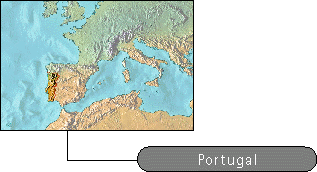

1. LOCATION AND GEOGRAPHY
Portugal is located in Southern Europe, on the western part of the Iberian Peninsula, bordered to the north and east by Spain and to the west and south by the Atlantic Ocean. Included in the national territory are the archipelago of Madeira, located in the Atlantic Ocean, southwest of continental Portugal, and the archipelago of the Azores, located in the Atlantic Ocean to the west of Southern Europe. Madeira Island is made up of the islands of Madeira and Porto Santo and the Deserted and Wild Islets. The Azores archipelago includes the islands of Santa Maria, São Miguel, Terceira, Graciosa, São Jorge, Pico, Faial, Flores and Corvo.
Surface area
91,831 Km²
(88,790 Km² Continental Portugal; 2,247 Km² Azores archipelago; 794 Km² Madeira
archipelago).
Landscape
Continental Portugal is mountainous north of the Tagus
River, with plains to the south; the highest point of the national territory
is the top of Mt. Pico, located on Pico island in the Azores archipelago.
Rivers
The most important rivers crossing Portuguese territory
start from springs Spain: the Minho River (75 km in Portugal), the Douro River
(322 km), the Tagus River (275 km) and the Guadiana River (260 km); the main
waterways that run exclusively in national territory are: the Mondego
River (220 km), the Sado River (165 km), the Vouga River (136 km) and the Mira
River (130 km).
Climate
Continental Portugal is located between latitudes 37°
and 42° north, with the Summer influenced by air masses associated with
the tropical anticyclone of the Azores, which brings dry and stable weather,
and in Winter influenced by air masses from the frontal systems of the middle
latitudes low areas which bring unstable and rainy weather. Average annual temperatures
don't exceed 17°-18° c. in the south of the continent, nor go below
13°-14° c. in the northern part. Rain is most intense in November and
December, in terms of volume.
2. POPULATION
9,862,540 (1991 census)
3. STRUCTURE OF THE PORTUGUESE STATE
Type of State
Republic, with Portugal a unified state that in it is organization respects the principles of municipal autonomy and democratic decentralization of the Civil Service. The archipelagos of the Azores and Madeira constitute autonomous regions, endowed with politico-administrative statutes and with their own Government bodies.
Organization of political power
President of the Republic
Is elected by direct, universal and secret vote by Portuguese citizens above the age of 18. His term is for 5 years, and he cannot be re-elected for a third consecutive term.President of the Republic - Dr. Jorge Sampaio (since March 9, 1996)
Parliament
Parliament is the representative assembly of all Portuguese. It is composed of a minimum of 180 and a maximum of 230 deputies. They are elected by universal, direct and secret vote of Portuguese citizens above the age of 18 according to the system of proportional representation and the Hondt method of the highest average.The elections held in February of 2005 led to the following distribution of seats: Socialist Party (PS) 121; Social Democratic Party (PSD) 75; Portuguese Communist Party (PCP) 12; Popular Party (CDS-PP) 12; Left Block Party (BE) 8; Green Ecological Party (PEV) 2.
President of Parliament - Dr. Jaime Gama (since March of 2005)
Government
The Government is the body that runs the general policies of the country and is the main body of the civil service.The Prime Minister is nominated by the President of the Republic, after hearing the parties represented in Parliament and taking into account the electoral results.
Prime Minister - Eng. José Sócrates (since March 2005)
Courts
Supreme Court of Justice and the 1st and 2nd Constitutional Court Supreme Administrative Court and other Administrative and Tax Courts Accounts Court
Administrative Division
Autonomous Regions of the Azores and Madeira and 18 districts (Aveiro, Beja, Braga, Bragança, Castelo Branco, Coimbra, Évora, Faro, Guarda, Leiria, Lisboa, Portalegre, Porto, Santarém, Setúbal, Viana do Castelo, Vila Real and Viseu).
LINKS TO COMPLEMENTARY DATA
April 25th Documentation Center
Geology and Minerals Institute
